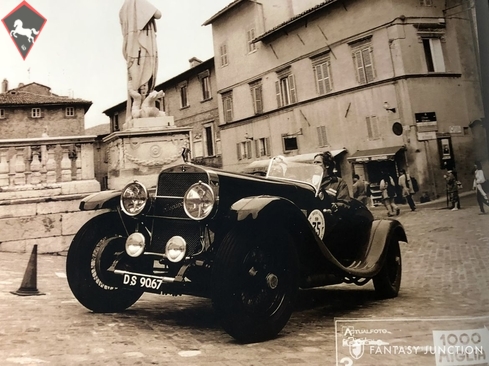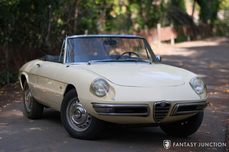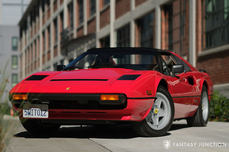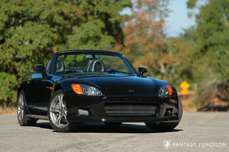Hispano-Suiza K6 6.6L Inline 6-Cylinder 1929
General description :
1930 Hispano-Suiza H6C Monza-Boulogne Spider
s/n 12400, Engine no. 320387
Dark Red with Maroon Wings and Black Leather
The luxurious and elegant Hispano-Suiza came to fruition at a time in automobile development when industry was booming, and individual wealth was increasing at historic rates. Overlapping with an increase in the wealthy “sporting elite”, the automobile soon became an important part of expressing a sense of adventure outside formerly traditional and largely static displays of wealth or status. Chosen by European royalty, Maharajahs, Hollywood film stars and industrial tycoons, the legendary Hispano-Suiza was brilliantly engineered, adorned with beautiful fixtures, capable of great performance, and fitted with an array of stunning coachbuilt bodies. Swiss engineer Marc Birkigt had proven his capabilities with Hispano-Suiza-engined Spad fighter planes in World War I, devising a lightweight aluminum casting engine utilizing steel liners, essentially creating the first block castings of their type, establishing Hispano-Suiza as a premier engineering firm. After their success supplying aircraft engines during WW1, Hispano-Suiza delivered the same brilliance to their new class of cars unveiled in 1919 at the Paris Auto Salon. The H6 series was not only the ultimate car of the time, built in Paris at the Bois Colombes factory, it was recognized as the most expensive car available in Europe.
Driven by their unceasing enthusiasm for perfection, Hispano-Suiza combined artisanship, excellence, and adventure with every vehicle they built. Nowhere was this more evident in Captain Georges Guynemer's Stork Squadron of Hispano-Suiza-engined Spads, which would become the mascot adorning the H6 radiator. The H6 featured a six-cylinder of 6,597cc capacity mated to a durable three-speed gearbox, with advanced servo-assisted four-wheel power brakes. So significant were the technical and engineering applications, that many rival companies, including Rolls-Royce sought out Hispano-Suiza patents for licensed applications to use on their own cars. Inspired by their involvement in aeronautical engineering, their advanced technology, attention to detail, and motoring excellence all combined to elevate the Hispano-Suiza brand to a world stage. Rolls-Royce, Isotta-Fraschini and Pierce-Arrow, all of whom were keenly under pressure to clear the bar that Hispano-Suiza was constantly raising, became eagerly aware of the challenge, particularly to discerning and wealthy clientele. Not only was the H6 an advanced chassis, the wide array of body styles encouraged privateers to modify their cars for racing events, rallies, and hill climbs.
After World War II, Hispano-Suiza would once again thrive as a major force of engineering, focusing their efforts primarily in the growing aerospace industry. As such, Hispano-Suizas today are not only astonishingly beautiful expression of engineering excellence, they are rare and highly desirable, particularly among collectors and enthusiasts who seek the finest in motoring excellence from this important era in automotive development.
At the outset of the H6 offering, European automobile manufacturing combined durable chassis construction with opulent and specifically tailored coachwork to meet the needs of wealthy clientele, while remaining suitable for a range of motoring affairs. As production developed, the H6 evolved into the B and eventually C series, the latter of which offered the larger 8 liter engine. Many examples left the factory with a particular sedan or formal body, later becoming the subject of one-off coachwork or as a specially constructed car to meet a specific purpose. Over the years, this has led to a wonderful array of prewar cars offering both unique histories and dynamic coachwork. Such is the case with this particularly extraordinary Hispano-Suiza.
The first owner of this exceptional example was the celebrated Frenchwoman and early Aeronautical Pioneer Suzanne Deutsch de la Meurthe, chevalier of the Legion of Honor. Daughter of Henry Deutsch de la Meurthe, also a chevalier (essentially the French equivalent of a British Knight) and prominent oil magnate. Encouraged by her father and his interests, Suzanne became an accomplished rally driver and airplane pilot, participating in many of the races and aviation events founded by her father. Among his many achievements in this area he’s credited as a co-founder of the Automobile Club de France and the Aero Club de France, in partnership with Gustav Eiffel, of towering French fame, as well as sponsoring the first flight around the Eiffel Tower, performed in a dirigible.
Suzanne de la Meurthe however would soon establish her own status as a prominent figure in aviation, becoming President of the Aero Club de France, while making great strides in humanitarian aid for post-war France. She personally funded aviation innovation research, and offered her own chateau as a charitable foundation for injured pilots, funded by her family wealth. Her efforts in the community and the aviation industry were all the more remarkable being a young woman in a field dominated by men.
Delivered new to Suzanne Deutsch de la Meurthe, this Hispano-Suiza was originally fitted with a Town Car body with coachwork by Binder. Having previously been the owner of a sporting Labourdette Skiff H6B, which she drove this car in the ‘all female’ 1930 Paris-Cannes Rally, she was already quite familiar with the marque. After her ownership of this H6C, the second owner was banker Paul Guilbert, who modified the Binder coachwork, distinctively identified by a rather far forward mounted chauffer’s seat, positioned to accommodate the height of his chauffer. After some years of neglect, the car was located in the 1950s and subsequently acquired by famous motorsports journalist Gerard “Jabby” Crombac. Having lived a life of legendary stature by any motorsports measure, Jabby’s list of close friends reads like a Who’s Who of racing from the 1950s and 1960s including Colin Chapman, Jimmy Clark, and Graham Hill.
Under his ownership, Jabby sought the counsel of BBC Motor Sports commentator and builder of amazing hill-climb specials, John Bolster, as well as Louis Rossigneux, a former Hispano-Suiza engineer and factory manager. With their expert guidance, Jabby made the astute selection to restore the car to the rare ‘Monza’ short wheelbase configuration, produced at the Hispan0-Suiza factory exclusively for motorsports competition, including The Indianapolis 500. A new body was formed with the assistance of Bolster and Rossigneux using available references derived from documentation of the Monza configuration. With none of the original Monza racecars remaining to use for reference or spare parts, Rossigneux, tapped his Hispano-Suiza factory connections, allowing him to obtain key parts for the shortened wheelbase configuration, including a critical factory made shortened cardan shaft, a competition camshaft, higher ratio axle, and other performance modifications, all of which resulted in a completed car capable of 120mph. Any doubt about the capability of such claims was put to rest when Jabby accompanied Colin Chapman himself to test drive the car at the Lotus Hethel test track, documented with a photo showing the two in the completed car at the Lotus track. After several years of ownership, Jabby sold the car in the 1970s and by 1991 it was sold via auction in Monte Carlo to the next owner, Tom Walduck. Under his ownership, Walduck commissioned a comprehensive rebuild of the engine in 1992 by Kerry McSwan with assistance from the Rolls-Royce factory. Walduck participated in two Mille Miglias with the car (1992 and 2000) as well as two Coys International Race events at Silverstone.
The current and consigning owner purchased the car in 2018 and has since performed a number of improvements to the car both cosmetically and mechanically. Engaging experts at Phil Reilly & Co., the car was delivered to Reilly in January 2019 where the wings (fenders) were removed for repainting using urethane paint with 2 stage clear coat. Work included light body work to the beaded edges, fender brackets, treating exposed hardware, and detailing for final assembly. During this time, the drive shaft coupling disc and driveshaft donut were replaced, oil and fluids replaced as needed. In May 2019 the car returned to Reilly & Co. due to fluid leaking from the engine compartment. The team carefully disassembled the engine to determine the source of the leak. During their investigations, research indicated that these engines tend to collect sediment in the corner of the engine, creating blockage in the water jacket. At this time, it was prudent to remove the cam shaft and cam bearings as well as the engine block from the car, slowly becoming evident that the engine would need comprehensive attention. Fortunately, the car was in expert hands. The engine block was sent out to an engine specialist with expertise in Lock-N-Stitch repair. During this time, other work was performed on the valves, camshaft, valves, pistons, and various other components. Upon returning to the shop, the engine was reassembled and tested, tolerances and lash reviewed, and then taken apart again for final fitting, cam timing, and other adjustments. The level of detail and thoughtful craftsmanship afforded during the engine service resulted in the completion by Feb 2020 with an invoice exceeding $23,000.00, not including the previous work that totaled over $27,000.00.
Today the car exhibits a powerful presence, both reflective of the now wonderfully patinaed restoration and recently completed mechanical work. The years of ongoing dedication from known ownership back to new are clearly evident not just in the service this wonderful Hispano-Suiza has seen, but in the curatorial preservation of a truly wonderful automobile. The beautifully constructed coachwork is both stately and sporting with two-tone paint showing excellent finish to the recently repainted fenders and brighter red body, which has mildly settled over years of enjoyable use. The fluid fender line is contrasted by intricate wire wheel construction, adorned with brightwork typical of the period, now with some areas showing gentle age. The upright grill and prominent French yellow beam Marchal headlamps convey an authentic and fitting presence to the excellence of this era, enhanced by the gentle hues of time, encompassing three countries of ownership.
The interior is nothing short of breathtaking, here again a rare combination of warmed wood tones, aircraft inspired instrumentation, raw materiality, and honest harmony. Even a glance under the dashboard reveals a vision of Jules Verne delight, complete with exposed hardware, electrical wiring, and handmade construction. Pleated red door panels and black leather seats complete the sporting interior of this magnificent H6C. Instrumentation including the Volt meter and tachometer have been recently serviced to ensure proper operation. The lasting impression this car delivers is one of awe and sporting excellence, in many ways a tribute to the bygone era of original construction, led by inspired ownership, stewarded with layers of ongoing engineering, culminating in a celebration of modern restoration artistry.
Under the hood, the themes of excellence continue not only with superlative mechanical restoration recently performed, but with excellent visual results. The engine is a pure delight of mechanical artistry, featuring beautiful castings, correct finishes, and original components all of which reminds even the most ardent enthusiast of modern machinery that all of this was conceived by hand, using pencil and paper, in an era of craftsmanship branded by heat and flowing metal.
The car is not only beautifully constructed, it is a genuinely easy and pleasure to drive. The starting procedure is a marvelous reminder of this era with throttle settings, levers and cranks, the car erupts to life promptly with a brilliant and authoritative symphony of mechanical sounds. Idle is even as the car warms, and the throttle response is crisp owning to a light flywheel. When underway in a spirited fashion as the engine pulls strong through nicely spaced gear ratios. The non-synchro gearbox has a wonderfully light mechanical feel, rewarding an attentive operator with delightful results, superior to Bentley’s of the era. Driving this car is a completely engaging and thrilling experience that commands your attention, from the quick-ratio steering and gear selection to hydraulic braking and using momentum as much as acceleration, driver and automobile becomes precise partners in an honest and compelling way. In both mechanical feedback and construction, this Hispano-Suiza is very well-resolved, compelling, and reflective of the ongoing care previous and current owners have lavished upon it.
The car is accompanied by a current FIVA card, older FIA Papers, an original Hispano-Suiza catalog, additional Hispano-Suiza period books and literature, a period publication featuring an article with Suzanne de la Meurthe on the cover, an exceptionally well-documented 50 page book published by a previous owner with accounts of previous ownership containing copies of period photos, specifications, recent invoices, and various literature on the car.
Great cars from this Classic Era are seldom available with such exceptional history, known ownership, and superlative mechanical condition. These rare and cherished objects of art are not only exciting moments of beauty, they transport us to unique experiences, connected to the past. With so many of these types of vehicles remaining static in museums, as fixtures of immobilized sculpture, it is all the more fitting that this Hispano-Suiza is capable and willing to deliver for events, tours, or shows with the same precision and excellence presented when new. Impressively constructed, this H6C offers the next owner a unique opportunity to experience open touring in one of the most dramatic and inspired pre-war automobiles.
Please note this H6C is sold on a UK V5 ownership document, with duty paid in the United States.
https://fantasyjunction.com/inventory/1929-hispano-suiza-h6-c-spider/overview
1929 Hispano-Suiza K6 6.6L Inline 6-Cylinder is listed sold on ClassicDigest in Emeryville by Fantasy Junction for $498500.
Car Facts
Car type : Car Make : Hispano-Suiza Model : K6 Model Version : 6.6L Inline 6-Cylinder Engine size : 0.0 Model Year : 1929 Location : Emeryville Vehicle Registration : Normal
Sold
Seller Information
Sold
Other cars listed for sale by this dealer
About Hispano-Suiza
The Birth of a Legend:Hispano-Suiza is a name that exudes luxury, elegance, and engineering excellence. The company was founded in 1904 by the talented Swiss engineer Marc Birkigt and Spanish businessman Damián Mateu. It was born from a shared vision to create exceptional automobiles.
Engineering Prowess:
Hispano-Suiza quickly gained a reputation for its engineering prowess. The company was known for its innovative and advanced designs, setting the bar for automotive technology. Birkigt's engineering genius was at the heart of every Hispano-Suiza vehicle.
Top Models:
Hispano-Suiza Alfonso XIII: One of the earliest successes was the Hispano-Suiza Alfonso XIII, named after the Spanish king. This car featured a powerful engine and elegant styling, making it a favorite among royalty and the elite.
Hispano-Suiza H6: The H6, introduced in the 1910s, was a masterpiece of engineering. It was one of the first production cars to feature four-wheel brakes, a significant safety innovation. The H6 was renowned for its performance and luxury.
Hispano-Suiza J12: The J12, introduced in the 1930s, was a symbol of opulence. Its V12 engine provided unmatched power and smoothness, and the car was a favorite of European royalty and celebrities.
Hispano-Suiza K6: The K6 was a smaller, more affordable model, but it still carried the hallmark of Hispano-Suiza quality. It was stylish and well-received in the luxury car market.
Hispano-Suiza Xenia: The Xenia was a concept car introduced in 1919 and showcased the brand's innovative spirit. It featured advanced engineering and an artistic, streamlined design.
Legacy and Decline:
Hispano-Suiza left an indelible mark on the automotive world. The brand's commitment to quality, innovation, and luxury earned it a place among the top automobile manufacturers. However, the Spanish Civil War and the economic challenges of the 1930s took a toll on the company.
Modern Resurgence:
While the original Hispano-Suiza ceased car production in the 1940s, a modern resurgence of the brand occurred in the 21st century with the Hispano-Suiza Carmen, an all-electric hypercar that paid homage to the brand's historic legacy.
Hispano-Suiza's history is a testament to the pursuit of automotive excellence, where innovation and luxury combined to create some of the most remarkable and iconic cars in the world. It continues to be a name associated with the highest standards of craftsmanship and design.






